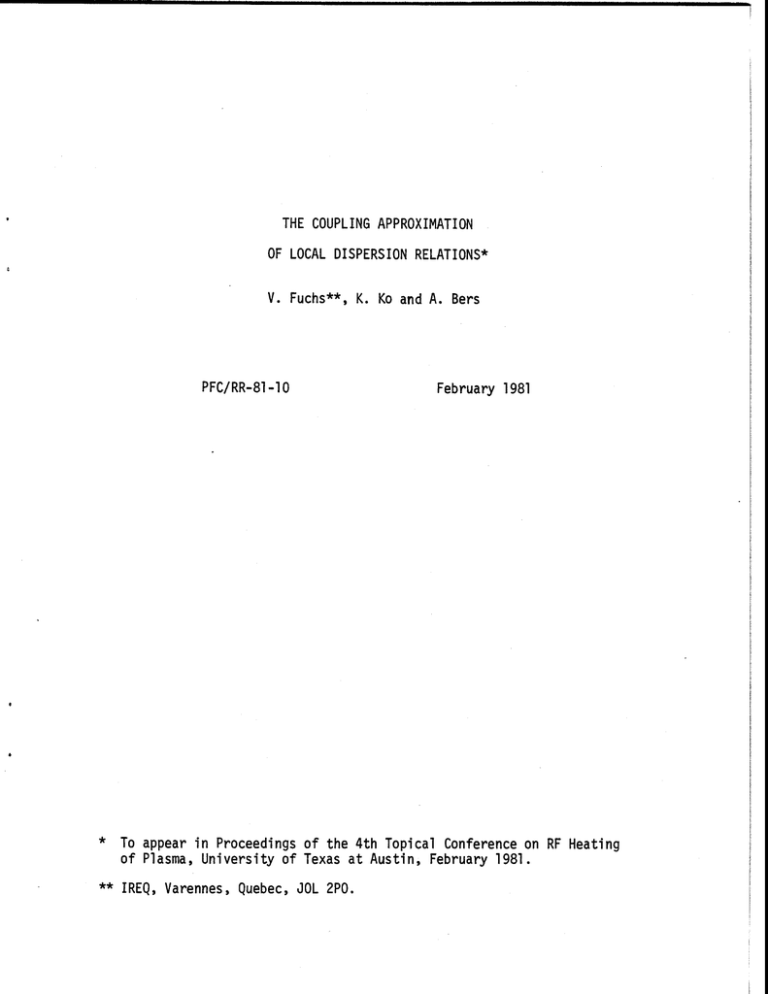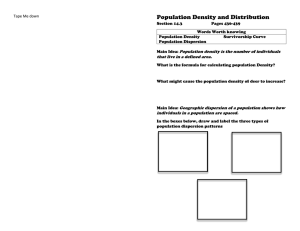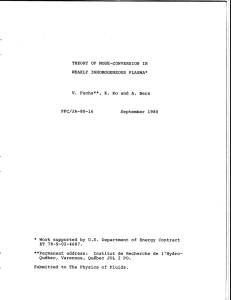THE COUPLING APPROXIMATION LOCAL A. 1981
advertisement

THE COUPLING APPROXIMATION OF LOCAL DISPERSION RELATIONS* V. Fuchs**, K. Ko and A. Bers PFC/RR-81 -10 February 1981 * To appear in Proceedings of the 4th Topical Conference on RF Heating of Plasma, University of Texas at Austin, February 1981. ** IREQ, Varennes, Quebec, JOL 2P0. THE COUPLING APPROXIMATION OF LOCAL DISPERSION RELATIONS* V. Fuchs, (I EQ, Varennes, Quebec, ,OL2PO K. Ko an(l A. Bers, NUT Plasma Fusion Center, Cambridge, MA 02139 The propagation of waves of a given frequency in one-dimensional njon-uniform media (coordinate x) with general local dispersion functions, e.g. D(k, x) (such as those from the Vlasov eqLarion), and not expressible as a polynomial in wavevector k has not previously been solved due to the difficulty of treating mode coupling regions where k values come together rapidly, and the eikonal approximation must fail. Providing the modes couple only two at a time, a general method is given for generating appropriate and unambiguous second-order differential equations for each coupling. The differential equation requiring solUtion is essentially the Schrodinger equation with potential -2(D(k)/O 2D/Ok 2)k=;(x), where kc(x) satisfies3D(k, x)/3k = 0, x real. Lower-hybrid heating of plasmas relies on the mode-conversion of incident electromagnetic power to a i ormal plasma mode which is more readily absorbed via non-collisional damping processes. The usual modecoupling theory' based on the fourth- or sixth-order differential equations corresponding to the warm-plasma approximation of the Vlasov dispersion relation is inapplicable in tile presence of kinetic damping. Specifically, tMe appearance, due to damping, of terms which are not powers of the wavenumber k breaks down the possibility of direct representation of the dispersion relation by a differential equation. Nevertheless, the concept can be recovered, and we present here a method of analysis resulting in a system of coupled-mode differential equations, representing any dispersion relation which is an entire analytic function of k. We are dealing here with "local" dispersion relations, valid for waves in a non--uniform medium (along x) satisfying the eikonal approximation. Consider a plasma which is weakly nonuniform in one spatial dimension x, supporting waves excited at a'fixed frequency u). The local dispersion relation D(k, z; w) = 0 representing these waves as they propagate under the influence of nonuniformities, defines a many valued mapping of the complex spatial variable z = x + iy onto the complex wavenumber plane k = k,. + iki. We have defined k = k,, and we have suppressed the explicit dependence on parameters such as the other two components of the wavevector, etc.; y and z are not to be confused with spatial dimensions. We will assume that the inverse mapping k -+ z is single-valued. It poses no principal difficulty to relax this assumption, and it is useful to do so on occasion, since the case of many valued z is frequently encountered in practice. An arbitrary contour C in the z-plane thus maps onto n branches, n > 1, k = f(z), and with such a mapping there are associated saddle and branch points, k, and zD, respectively. The branch points z13 are those for which 1 diverges, and they are, by definition, the only ones which map onto a single point k, in the k-plane, the latter being the saddle points of the inverse mapping z = f~1(k). The general procedure of mapping z -- k through the dispersion relation involves two steps. The first is * to determine the saddle points k, and branch points zB. The second is to specify the branch lines. The saddle and branch points are inherent to the mapping. Each saddle point defines a distinct coupling event between the branches- we will assume throughout that the branches couple pair-wise, which occurs when *Work supported by National Science Foundation Grant No. 77-00340-A01. I df -t dk d2f- dk 2 o. The crucial step in the analysis of the dispersion relation regards the construction of branch cuts. On the one hand, the branch cuts define the process of mode coupling and the process of analytic continuation of a branch. but on the other, the dispersion rel ition alone does not provide any ready-made in formation on how to :pcCify the branch lines. This is, of course, 1source of major concern since mode coupling occurs, by definition, O'vcry time the wa\e-propagation contour C (the real axis x = Re z) crosses a branch cut. The intuitive reaction in this situation would be to trace the bratich cuts in some arbitrary manner away from the real axis, to avoid crossings other than through the branch points themselves. But what if all branch points lie away from the real axis? Does this imply that now no niode coupling takes place? The answer to these questions lies in the I roper definition of mode-coupling and of a mode itself. The relevant question to ask is which are the physical L onditions for coupling and find their anal tical counterparts. Branches couple, by definition, whenever the real ;,-axis crosses a branch cut (Fig. 1). The asual definition of a mode, in terms of a branch of the dispersion relation, is thus not complete without associating with it a properly cut Riemann sheet. The Riemann sheet then maps onto a simply connected region of th- k-plane, whose boundaries (given by the maps of the branch cuts) limit the extent of wavenumbers accessilble to the branch under deformations of the x-axis. The required branch cuts CQ and the mode-boundaries k, arc given by the mappings 2 D(ke, C) =- 0, OD(k,, z) = 0, z E C, (2) where C is required to pass through the branch points and, therefore, might occasionally deviate from the real r-axis (Fig. 2). The only coupling events which materialize under these conditions are those defined by the branch (and saddle) points of the dispersion relation. We emphasize that it is actually through the mapping = 0 that we make contact with the physical requirements for mode-conversion. The argument goes as follows. Consider a wave A(x) exp [-iwt + ikr(x)x propagating along the x-direction, and characterized by a slowly varying amplitude A (incorporating the effect ofki(x)) and wavenumnber kr(x). The wave has associated with it an averaged energy flux proportional to vAA*, where A* is the conjugate to A, and v. is die local group velocity dw (3) evaluated implicitly from the dispersion relation D(k, z; w) 0. h'lie energy flux thus defined depends on position not only through the amplitude A, but also via vg. Under these conditions, energy ceases to flow in the form of a particular mode where either A -+ 0 or v. -+ 0. h'le former case is indicative of dissipative processes and A vanishes gradually. We are concerned with tie latter case as that is the one which is indicative of mode-conversion, at least as far as the coupling of energy between different wave-types is concerned. This is because when vg -+ 0 without A vanishing simultaneously, the global conservation of energy flux requires that tie energy be either transformed into a different wave form, or the amplitude diverges and we have a resonance. The branch points and branch cuts are instrumental in obtaining a representation of the dispersion relation in tie form of a system of sccond-order differential equations. To proceed let us define the function 3(k) = D(k, z) of the independent variable k, with z as a parameter. To obtain an approximation for the two roots k of the dispersion relation which couple at k = k,, we expand !(k) around the corresponding mode- boundary ke,(z) to second-order in k: 9(k) = 9(k.) + 1 (k - kc)29"(k). 2 This approximation for U(k) is excellent near the coupling points k, and zB, by virtue of the definition of kc(z), providing that 9"(k,) = 0. Moreover, it is a good approximation away from k, and zt, as long as G"(ke) does not vanish in the region of interest. The latter condition is particularly important when the branch point is not real, since then the approximation must be extended all the way from zjj to the rea' axis, which is where the waves actually propagate. It follows that the particular path in the z-plane must avoid passing through a branch point of the mapping OU = 0, since G"(k,,) vanishes there and kj(z)joins onto a dilferent branch. Except for this restriction, the path can be quite arbitrary, and the transition to the real axis can be therefore performed by substituting - for z and making sure that kc(x) belongs to the correct branch as specified by the appropriate saddle point k.(zn) = ks. The dispersion rc lation '(k) = 0 on the real axis Re z is thvn approximated by k' - 2kc(x)k + k (x) - Q(x) = 0, (4) where Q(r) = -2 6(k)/9"(k)k (x). (5) is the scattering potential. We now note thai Eq. (4) contains the ambiguous combination kek which permits the interpretations (k -+ i-I) ike 3L) , i d(cF)/dx, or a linear combination thereof, where (D is the wave-potential. The criterion for deciding the existence of a unique combination of these terms is that the resulting equation must have regular turning points wher Q = 0, as this is where, by definition, th, inapping represented by the dispersion relation has branch points. Such a combination does indeed exist, and te differential equation is 4," + ikcV' + i(kcf)' + (Q - ke)( - 0, (6) where the prime now denotes differentiation with respect to x. To prove that Eq. (6) has the desired turning points it suffices to write (D = p exp (-i f kc(x) dx) = (pF, giving finally P"+ Q(X)p = 0. (7) The system, composed of the elementary local dispersion relations (4), together with their corresponding differential equations (7) can be appropriately termed as the "coupling approximation" of the dispersion relation. An application of the method pertaining to the mode-conversion of lower-hybrid waves in the presence of ion-cyclotron damping is given in a companion paper of these Proceedings. References [1] T. H. Stix, Phys. Rev. Leti. 15, 878 (1965); W. Wasow, Ann. Math. 52, 350 (1950); A. L. Rabenstein, Arch. Ration. Mech. Anal. 1 418 (1958); V. S. Chan, S. C. Chiu, and G. E. Guest, Phys. Fluids 23, 1250 (1980). [2] V. Fuchs, K. Ko, and A. Bers, Phys. Fluids (to be published). 3 y BRANCH CUT Cb f (C) ks= f (C) UB f (Cb) C' Cx kr Figure 1. For a contour C not crossing the branch cut. Q, the branches f(C) lie, unconnected, on either the map. f(C,). Of the cut. A branch cut itnclf maps onto the k-plane as extending from the saddle point two directions, and represenms the boundary between the maps of the two Riemann sheets it connects. other case, of C' crossing th- branch cut, the branches connect through the boundary f(Cb) signifying a coupling event. side of k, into In the mode- y Cb zB B x B f (Cb) A -< s B kr ki ksr AI kr B Fipmre 2. The assumption of pairwise cotIpling reduces he problem of an n-valued mapping into a series of IO wvalued maps. If the branch point lies away from' the reai x-axs. the branches appear uncoupled in both the A. k, versus kr, as well as in the inore farniliaki, k, versus ~--- r, representations. I 4







